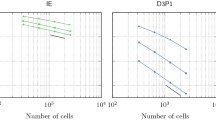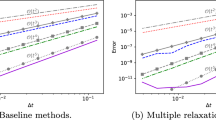Abstract
We consider new implicit–explicit (IMEX) Runge–Kutta methods for hyperbolic systems of conservation laws with stiff relaxation terms. The explicit part is treated by a strong-stability-preserving (SSP) scheme, and the implicit part is treated by an L-stable diagonally implicit Runge–Kutta method (DIRK). The schemes proposed are asymptotic preserving (AP) in the zero relaxation limit. High accuracy in space is obtained by Weighted Essentially Non Oscillatory (WENO) reconstruction. After a description of the mathematical properties of the schemes, several applications will be presented
Similar content being viewed by others
References
Arora, M., and Roe, P. L. (1998). Issues and strategies for hyperbolic problems with stiff source terms in Barriers and challenges in computational fluid dynamics, Hampton, VA, 1996, Kluwer Academic Publication, Dordrecht, pp. 139–154.
U. Ascher L. Petzold (1998) Computer Methods for Ordinary Differential Equations, and Differential Algebraic Equations SIAM Philadelphia
U. Ascher S. Ruuth R.J. Spiteri (1997) ArticleTitleImplicit-explicit Runge–Kutta methods for time dependent partial differential equations Appl. Numer. Math. 25 151–167 Occurrence Handle98i:65054 Occurrence Handle10.1016/S0168-9274(97)00056-1
U. Ascher S. Ruuth B. Wetton (1995) ArticleTitleImplicit-explicit methods for time dependent PDE’s SIAM J. Numer. Anal. 32 797–823 Occurrence Handle96j:65076
A. Aw M. Rascle (2000) ArticleTitleResurrection of second order models of traffic flow? SIAM. J. Appl. Math. 60 916–938 Occurrence Handle2001a:35111 Occurrence Handle10.1137/S0036139997332099
A. Aw A. Klar T. Materne M. Rascle (2002) ArticleTitleDerivation of continuum traffic flow models from microscopic follow-the-leader models SIAM J. Appl. Math. 63 259–278 Occurrence Handle2003m:35148 Occurrence Handle10.1137/S0036139900380955
R.E. Caflisch S. Jin G. Russo (1997) ArticleTitleUniformly accurate schemes for hyperbolic systems with relaxation SIAM J. Numer. Anal. 34 246–281 Occurrence Handle98a:65112 Occurrence Handle10.1137/S0036142994268090
G.Q. Chen D. Levermore T.P. Liu (1994) ArticleTitleHyperbolic conservations laws with stiff relaxation terms and entropy Comm. Pure Appl. Math. 47 787–830 Occurrence Handle95h:35133
B.O. Dia M. Schatzman (1996) ArticleTitleCommutateur de certains semi-groupes holomorphes et applications aux directions alternées Math. Modelling Num. Anal. 30 343–383 Occurrence Handle97e:47055
S. Gottlieb C.-W. Shu (1998) ArticleTitleTotal variation diminishing Runge–Kutta schemes Math. Comp. 67 73–85 Occurrence Handle98c:65122 Occurrence Handle10.1090/S0025-5718-98-00913-2
S. Gottlieb C.-W. Shu E. Tadmor (2001) ArticleTitleStrong-stability-preserving high order time discretization methods SIAM Review 43 89–112 Occurrence Handle2002f:65132 Occurrence Handle10.1137/S003614450036757X
E. Hairer (1981) ArticleTitleOrder conditions for numerical methods for partitioned ordinary differential equations Numerische Mathematik 36 431–445 Occurrence Handle0462.65049 Occurrence Handle82j:65047 Occurrence Handle10.1007/BF01395956
E. Hairer S.P. Nørsett G. Wanner (1987) Solving Ordinary Differential Equations, Vol 1 Nonstiff problems Springer-Verlag New York
E. Hairer G. Wanner (1987) Solving Ordinary Differential Equations, Vol.2 Stiff and Differential-algebraic Problems Springer-Verlag New York
Jahnke T., Lubich C. (2000). Error bounds for exponential operator splitting. BIT 735–744
J. Jenkins M. Richman (1985) ArticleTitleGrad’s 13-moment system for a dense gas of inelastic spheres Arch. Rat. Mech. Anal. 87 355–377 Occurrence Handle86b:73032 Occurrence Handle10.1007/BF00250919
S. Jin (1995) ArticleTitleRunge–Kutta methods for hyperbolic systems with stiff relaxation terms J. Comput. Phys. 122 51–67 Occurrence Handle0840.65098 Occurrence Handle96g:65084 Occurrence Handle10.1006/jcph.1995.1196
S. Jin Z.P. Xin (1995) ArticleTitleThe relaxation schemes for systems of conservation laws in arbitrary space dimensions Comm. Pure Appl. Math. 48 IssueID3 235–276 Occurrence Handle96c:65134
C.A. Kennedy M.H. Carpenter (2003) ArticleTitleAdditive Runge–Kutta schemes for convection-diffusion-reaction equations Appl. Numer. Math. 44 139–181 Occurrence Handle2003m:65111 Occurrence Handle10.1016/S0168-9274(02)00138-1
R.J. LeVeque (1992) Numerical Methods for Conservation Laws BirkhauserVerlag Basel
S.F. Liotta V. Romano G. Russo (2000) ArticleTitleCentral schemes for balance laws of relaxation type SIAM J. Numer. Anal. 38 1337–1356 Occurrence Handle2001j:65128 Occurrence Handle10.1137/S0036142999363061
T.P. Liu (1987) ArticleTitleHyperbolic conservation laws with relaxation Comm. Math. Phys. 108 153–175 Occurrence Handle0633.35049 Occurrence Handle88f:35092 Occurrence Handle10.1007/BF01210707
Marquina, A., and Serna, S. (2004). Capturing Shock Waves in Inelastic Granular Gases, UCLA-CAM Report, 04–04
L. Pareschi (2001) ArticleTitleCentral differencing based numerical schemes for hyperbolic conservation laws with stiff relaxation terms SIAM J. Num. Anal. 39 1395–1417 Occurrence Handle1020.65048 Occurrence Handle2002j:65086
L. Pareschi G. Russo (2001) ArticleTitleImplicit-explicit Runge-Kutta schemes for stiff systems of differential equations. Adv Theory Comput Math. 3 269–289 Occurrence Handle2005a:65065
Pareschi, L., and Russo, G. (2003). High order asymptotically strong-stability-preserving methods for hyperbolic systems with stiff relaxation, Proceedings HYP2002, Pasadena USA, Springer, Berlin, 241–255.
Pareschi, L., and Russo, G. (2004). Stability analysis of implicit–explicit Runge–Kutta schemes. preprint.
J. Qiu C.-W. Shu (2002) ArticleTitleOn the construction, comparison, and local characteristic decomposition for high-order central WENO schemes J. Comput. Phys. 183 IssueID1 187–209 Occurrence Handle2003j:65083 Occurrence Handle10.1006/jcph.2002.7191
C.-W. Shu (1988) ArticleTitleTotal variation diminishing time discretizations SIAM J. Sci. Stat. Comput. 9 1073–1084 Occurrence Handle0662.65081 Occurrence Handle90a:65196 Occurrence Handle10.1137/0909073
Shu C.-W. (2000). Essentially Non Oscillatory and Weighted Essentially Non Oscillatory Schemes for Hyperbolic Conservation Laws, in Advanced numerical approximation of nonlinear hyperbolic equations, Lecture Notes in Mathematics, 1697, 325–432.
C.-W. Shu S. Osher (1988) ArticleTitleEfficient implementation of essentially nonoscillatory shock-capturing schemes J. Comput. Phys. 77 IssueID2 439–471 Occurrence Handle89g:65113 Occurrence Handle10.1016/0021-9991(88)90177-5
R.J. Spiteri S.J. Ruuth (2002) ArticleTitleA new class of optimal strong-stability-preserving time discretization methods. SIAM J. Num. Anal. 40 IssueID2 469–491 Occurrence Handle2003g:65083
G. Strang (1968) ArticleTitleOn the construction and comparison of difference schemes SIAM J. Numer. Anal. 5 505–517 Occurrence Handle38 #4057 Occurrence Handle10.1137/0705041
Toscani G. Kinetic and hydrodinamic models of nearly elastic granular flows. Monatsch. Math. 142(1–2):179–192
G.B. Whitham (1974) Linear and Nonlinear waves Wiley New York
X. Zhong (1996) ArticleTitleAdditive semi-implicit Runge–Kutta methods for computing high speed nonequilibrium reactive flows J. Comp. Phys. 128 19–31 Occurrence Handle0861.76057
Author information
Authors and Affiliations
Corresponding author
Rights and permissions
About this article
Cite this article
Pareschi, L., Russo, G. Implicit–Explicit Runge–Kutta Schemes and Applications to Hyperbolic Systems with Relaxation. J Sci Comput 25, 129–155 (2005). https://doi.org/10.1007/s10915-004-4636-4
Received:
Accepted:
Issue Date:
DOI: https://doi.org/10.1007/s10915-004-4636-4
Keywords
- Runge–Kutta methods
- hyperbolic systems with relaxation
- stiff systems
- high order shock capturing schemes




